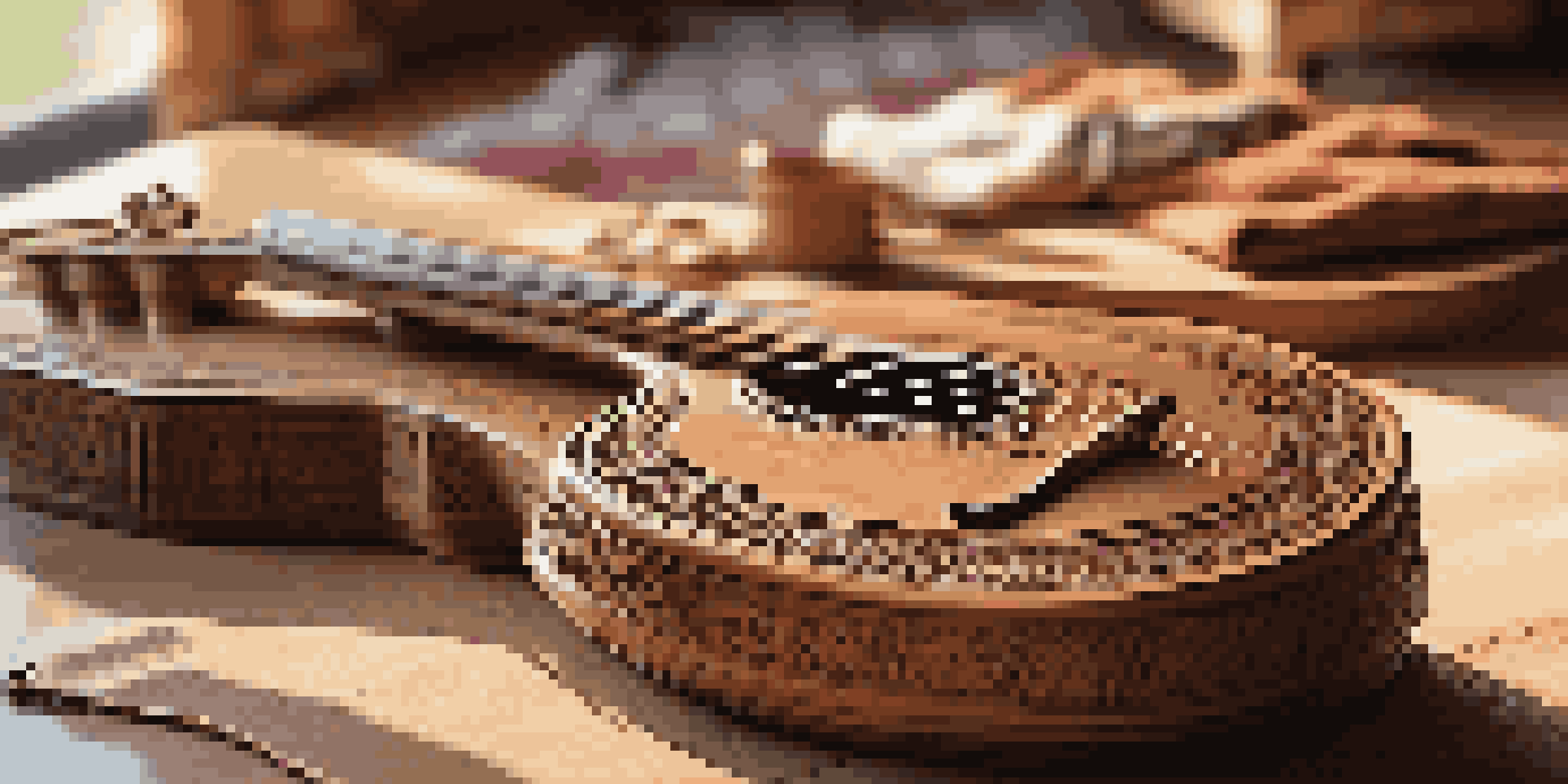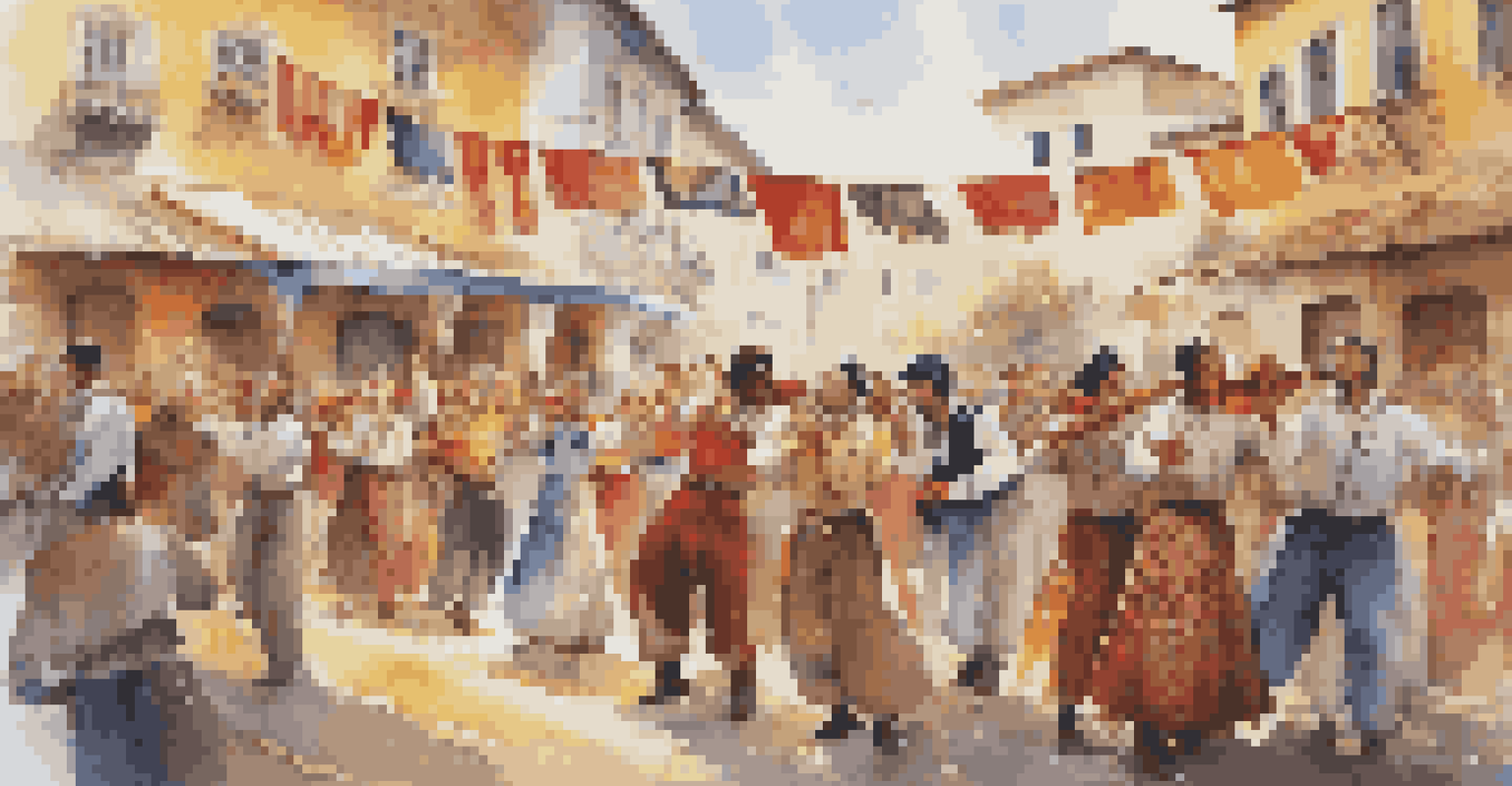The Lira: A Traditional Instrument of the Balkans

The Origins of the Lira in Balkan Culture
The lira has deep roots in the rich tapestry of Balkan culture, dating back centuries. It is believed to have evolved from ancient stringed instruments, making it a symbol of musical heritage in the region. With its unique sound and craftsmanship, the lira is not just an instrument; it embodies the spirit and traditions of the people who play it.
Music is the shorthand of emotion.
Traditionally crafted from wood, the lira features a distinctive shape that allows it to produce resonant melodies. Each lira is often handmade, showcasing the skill and artistry of local craftsmen who infuse their own heritage into the instrument's design. As a result, no two liras are alike, making each one a unique piece of art.
The lira's origins are intertwined with Balkan folklore and storytelling, often accompanying dances and celebrations. This connection to cultural rituals highlights the importance of the lira in community gatherings, where music serves as a bridge between generations, preserving stories and traditions through song.
Construction and Craftsmanship of the Lira
Crafting a lira is an intricate process, involving a deep understanding of both music and woodworking. Artisans start with high-quality wood, selecting types that enhance the instrument's tonal quality. The meticulous shaping and tuning of the lira result in its signature sound, which is both vibrant and soulful.

The lira typically features two or three strings, which are played using a bow, producing a warm, rich tone. This simplicity in design contrasts with the complex sounds it can create, illustrating the beauty of traditional craftsmanship. Each string is carefully adjusted to ensure harmony, reflecting the skill and patience of the lira maker.
Lira's Cultural Roots in the Balkans
The lira is deeply embedded in Balkan culture, symbolizing musical heritage and community traditions.
Moreover, artisans often incorporate decorative elements, such as carvings or inlays, which tell their own stories and represent local culture. These embellishments not only enhance the visual appeal of the lira but also connect it to the broader artistic traditions of the Balkans, making each instrument a cherished heirloom.
The Lira's Role in Balkan Folk Music
In the realm of Balkan folk music, the lira takes center stage, playing a crucial role in shaping the sound and feel of traditional melodies. It often accompanies dances, celebrations, and rituals, creating an atmosphere of joy and community. The vibrant tunes of the lira can evoke a range of emotions, from nostalgia to exuberance.
The beauty of music is that it connects people. It speaks to the soul in a language we all understand.
Musicians skilled in playing the lira often integrate it with other traditional instruments, such as the tamburica or accordion, enriching the musical experience. This interplay of sounds creates a dynamic fusion that is characteristic of Balkan music, allowing the lira to shine as a solo instrument or as part of a larger ensemble.
Moreover, the lira serves as a vehicle for storytelling, as songs performed on this instrument often recount tales of love, loss, and everyday life. These narratives resonate deeply with listeners, fostering a connection to the past and celebrating the enduring legacy of Balkan culture through music.
Regional Variations of the Lira
Across the Balkans, the lira manifests in various forms, reflecting the diverse musical traditions of the region. Each country boasts its own unique style of playing and crafting the instrument, resulting in a rich tapestry of sounds and techniques. For example, the Bulgarian lira may differ in tuning and construction from its Serbian counterpart.
These regional variations not only highlight local musical preferences but also showcase the adaptability of the lira within different cultural contexts. Musicians often incorporate local rhythms, melodies, and even dance styles, making the lira a versatile instrument that evolves with the times while still honoring its roots.
Craftsmanship and Unique Design
Each lira is handcrafted, making it a unique artistic expression that reflects local culture and craftsmanship.
As musicians travel and collaborate across borders, the lira continues to bridge cultures, reminding us that music knows no boundaries. This cross-pollination of styles enriches the musical landscape of the Balkans, ensuring that the lira remains a vibrant part of the region's cultural identity.
The Lira in Contemporary Music
While the lira has its origins in traditional music, it has also found a place in contemporary genres, breathing new life into its sound. Modern musicians are experimenting with the lira, blending traditional melodies with contemporary styles like fusion, jazz, and even pop. This innovative approach not only preserves the lira's legacy but also introduces it to new audiences.
Artists are increasingly incorporating the lira into their compositions, using it as a central instrument or as part of a larger ensemble. This fusion creates a fresh sound that resonates with younger generations, ensuring the lira remains relevant in today's music scene. The result is a delightful mix of old and new, appealing to both traditionalists and modern music lovers alike.
Moreover, this modern embrace of the lira showcases its versatility, as it adapts to various musical contexts and genres. By integrating the lira into contemporary music, artists honor the past while paving the way for future generations to explore and appreciate this unique instrument.
The Lira's Cultural Significance in the Balkans
Beyond its musical attributes, the lira holds cultural significance in the Balkans, representing identity, heritage, and community. It serves as a reminder of the rich traditions that have shaped the region over centuries. For many, the sound of the lira evokes a sense of belonging and nostalgia, connecting them to their roots and shared experiences.
The lira is often featured in festivals and cultural events, where musicians gather to celebrate their heritage through music. These gatherings create a sense of unity and pride, as participants share their love for the lira and the stories it conveys. This communal aspect reinforces the importance of preserving the lira as a vital part of Balkan culture.
Lira's Evolution in Modern Music
The lira is being embraced in contemporary genres, blending traditional sounds with modern styles to reach new audiences.
Furthermore, the lira represents resilience, as it has survived through historical changes and challenges in the region. Its continued presence in music and culture underscores the enduring spirit of the Balkan people, who have embraced their traditions while adapting to an ever-changing world.
Preserving the Lira for Future Generations
As we look to the future, preserving the lira and its traditions becomes increasingly important. Various initiatives, such as workshops, music schools, and cultural exchanges, aim to educate new generations about the lira's significance and techniques. By passing down this knowledge, we ensure that the lira remains a living part of Balkan culture.
Moreover, the rise of social media and digital platforms has opened new avenues for sharing the lira's music with a global audience. Musicians can now reach listeners far beyond their local communities, fostering a greater appreciation for this beautiful instrument. This visibility helps to elevate the lira within the global music landscape.

Encouraging young musicians to explore the lira can spark renewed interest and creativity, as they blend traditional elements with contemporary influences. By nurturing this passion, we can ensure that the lira continues to thrive, enriching the cultural fabric of the Balkans for generations to come.